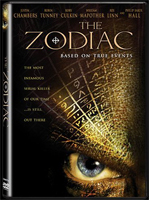 BUY IT AT AMAZON: CLICK HERE
BUY IT AT AMAZON: CLICK HERE
STUDIO: THiNKFilm
MSRP: $29.99
RATED: R
RUNNING TIME: 96 Minutes
SPECIAL FEATURES:
•Commentary with writer Kelly Bulkley and Alexander Bulkley
•“Behind The Zodiac” Featurette
•The Zodiac Letters and Ciphers
•Chronology of The Zodiac Killings
•Theatrical Trailer
The Pitch
“Okay, I wanna make a crime drama, but all I can come up with is generic crime-drama stuff, I need to inject this with SOMETHING even remotely interesting.” “Why not set it amongst The Zodiac Killings?” “Of course!”
The Humans
Justin Chambers, Robin Tunney, Rory Culkin
The Nutshell
In the late ‘60s and early ‘70s, The Zodiac Killer terrorized the San Francisco Bay area, murdering people at random. People tried to catch him (Notice how a bland and lifeless presentation of an interesting story can make the story itself bland and lifeless? Welcome to The Zodiac!).
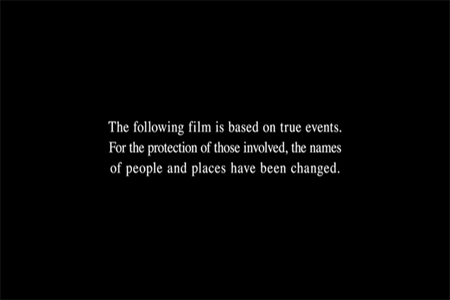
Understatement of the fucking year.
The Lowdown
I’d like to preface this review with two things before I jump into it. First, this review will be a bit spoilery in regards to the Zodiac case itself. If you’re not familiar with certain details of the case then go ahead and stop reading now. Secondly, a lot of people may look at this and see it as a release meant to cash in on the recent success of David Fincher’s masterpiece. It’s not. This film was released in 2005 and due to a combination of unreliability on my part and an interest to see Fincher’s film for a comparison, I give you this rather late review.
That said, this isn’t going to be a standard “comparison” review, mainly because of the fact that this film was released well in advance of this year’s Zodiac and it wouldn’t be fair to judge this film against Fincher’s.
On the other hand, fuck this movie.
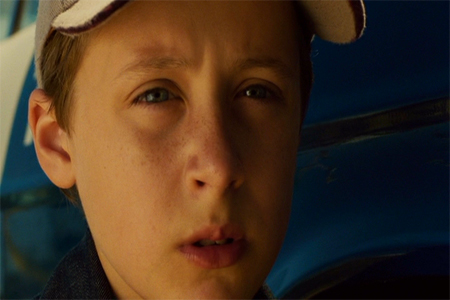
"Goddamn you Cameron Bright. I’ll get you – if it’s the last thing I do I’ll get you."
The Zodiac, written and directed by brothers Kelly and Alexander Bulkley (respectively), is a movie that, admittedly, had its heart in the right place. The story of the Zodiac is an immensely interesting one, ripe with a cinematic quality. The fact that they never caught the guy gives any filmmaker an excellent opportunity to naturally circumvent the standard Hollywood Ending, and aside from The Zodiac himself (who’s arrogance and ingenuity gives him a natural charisma for a filmic bad guy), the real people involved with this case are interesting people whose lives were effected in a completely narrative way. This whole story is literally a living, breathing movie.
So, with the entire thing laid out for you it should be fairly easy to pull a good movie out of it – even if you‘re not David Fincher. Well, the joke‘s on me, apparently, because the Bulkleys managed to generalize, dilute and white-wash every single goddamn element, character and basic fundamental of this story.
First of all, The Zodiac wreaked havoc all over the Bay Area and if you’re going to properly tell the story, you need to acknowledge the geographical aspects of it. Police departments everywhere were stumped, each with different pieces of the puzzle and the lack of communication between the various precincts played a big part in the uphill battle these guys faced. Here, we’re centralized completely in Vallejo and, even though the film’s murders took place where they were supposed to, there was no attention given to how those other locations affected the case in Vallejo (and elsewhere). Actually, once the murders left the Vallejo area, they seemed to take the focus off of The Zodiac and the investigation completely, focusing on our cop and his family – back in Vallejo. That proved to be extremely jarring, as they made a point to SHOW the murders in the other locations, but they ended up being completely disembodied from the story that was unfolding.
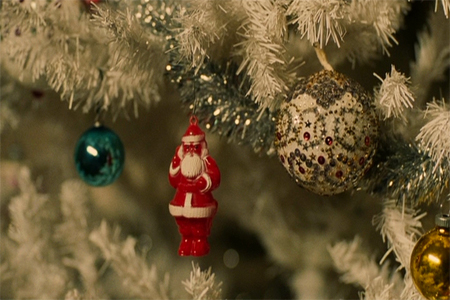
Uh oh – looks like someone forgot the sunscreen! Make your tree the envy of the block with the "Santa’s Vacation" ornament – exclusively at Hallmark Gold Crown Stores!
Speaking of our cast of characters, the wide and diverse roster from the real story has been squished and cris-crossed and mashed up into three key people. Dave Toschi, the investigators from everywhere else and basically anyone involved in the police side of things were squeezed into (fictional) Vallejo Police Sgt. Matt Parish (Justin Chambers). And even if you only focus on Toschi, they took his desperate sense of responsibility and obligation (and subsequent burnout) and transformed it into Generic Stressed Out Cop Who Chain Smokes and Comes Home Drunk and Yells at His Wife and as He Gets SO Obsessed With The Case He Crosses a Line and Gets Demoted to Beat Cop While the Zodiac Continues to Kill So He Feels Like a Failure and Even Though it Never Shows Him Commit Suicide You Kind of Hope He Does Because He’s Such a Douche. How’s THAT for characterization!? Chambers spends almost the entire movie with the same tortured look of failure and stress on his face and he makes sure to hit every single clichéd detective characteristic on his way to the end of a completely useless arc. And because he is our Toschi, his make-believe arc is so completely asinine and it just boggles the mind as to why they didn’t just follow the ACTUAL arc that the real Toschi did. And that doesn’t even consider the stories of the other real police detectives that were completely disregarded.
Robert Graysmith, the cartoonist who became completely obsessed with the case, who refused to let it die, who essentially (if you believe the theories) SOLVED the damn thing, has been relegated to the character of creepy-kid Johnny Parish (Sgt. Matt’s Son – played by Rory Culkin). Graysmith was arguably the most important character in the entire story and to 1) not even reference him, even indirectly and 2) seemingly replace him as a little kid is such a confusing decision. It’s POSSIBLE that Johnny Parish was just meant to be the cop’s son who gets too obsessed with his Daddy’s work and trying to solve the case, but the parallels to Graysmith are a little too apparent and I don’t feel that I’m off base making that connection.
And finally, remember Paul Avery? He’s been replaced by slimy Dale Coverling (a pretty decent performance by William Mapother). And yes, while Paul Avery was as sleazy as they come, the Zodiac Case led to his ultimate downfall and hitting rock-bottom, while Coverling used the case to elevate his career, from Random Article Guy in the Vallejo paper to a full-fledged News Anchor. This one I’m not too concerned about, as I’m sure there were sleazy press people who used the case to explode in their career. But if you’re going to focus on a member of the press, then why not focus on the most pivotal one?
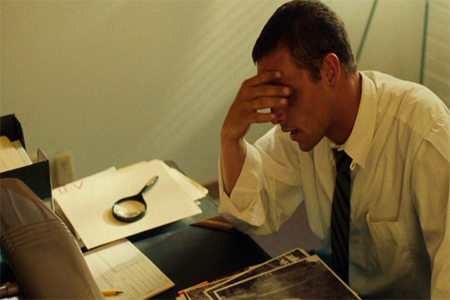
Robert just couldn’t face the fact that he finally had to surrender to the magnifying glass to find that Waldo. Aging, man. It’s a bitch.
Now, I know what you’re probably thinking – what if they COULDN’T tell the real-life stories of the real-life people involved, due to rights or affordability? Well, I did consider that – it’s very possible that Fincher had already snapped up the rights to these people for his film (although, if that were the case, it would SEEM like they would make mention of that in the commentary, but I digress). And I can understand that, but if that WAS indeed the case, then where the filmmakers showed incredibly idiotic judgement was trying to tell a fake story about fake people DIRECTLY involved with the case and the investigation. The interest derived from the case itself was because of the people involved and if you can’t touch those people, then don’t piss all over their story by exploiting and mangling it into something vaguely recognizable yet incredibly hollow. It’s lazy, it’s boring and it’s disrespectful. Had they made a movie about The Zodiac’s impact on society, using the killings and the case as a simple backdrop, then I would probably be writing a different review. It’s been done before with Pearl Harbor, Summer of Sam and Forrest Gump (although the quality of those films could prove to punch a hole in my argument), just to name a few, and it only seems like the best place to go if you can’t, for legal reasons, tell the actual story.
And speaking of telling a story, let me offer up my final complaint – after Zodiac sends the letter about picking off the school children, we see the standard shot of worried parents putting their kids on the bus – AND THEN IT ENDS. Done. Over. There’s a little blurb about the fact that he was never caught, but then the credits roll. What the fuck? You’re going to make a movie about the actual case and the actual investigation and then END it right in the middle? No representation of Arthur Leigh Allen? No mention in the blurb about Graysmith or the continuation of the case? Nothing? It’s fucking over? What were these guys thinking? Granted, there’s a LOT of material in this story and I can see how it would be daunting to try and make a film that covers it all, but shit man, if you’re going to do it, do it right. Which, again, is why it was the dumbest thing in the world to try and make a movie about the actual case if you couldn’t do it properly.
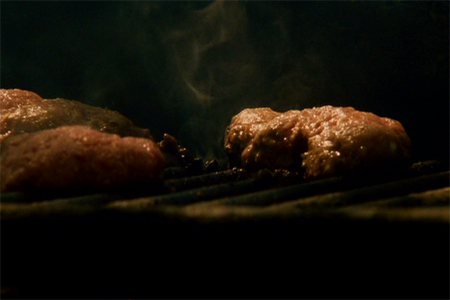
"It may LOOK like a standard barbecue grill, but just wait until you find out what happens on When Good Grills Go Bad! Friday at 7 on FOX!"
So, to sum it up, without all The Zodiac business, it’s a stupid, lifeless movie. With The Zodiac story being such a central part of the film, it goes from simply stupid to insulting.
Fuck this movie, indeed.
The Package
The cover-art on display is decent, if not a little generic. It’s well designed, but it focuses too much on The Zodiac Killer, making one think that the movie is actually centered around him. And the tagline is “The Most Infamous Serial Killer of Our Time…Is Still Out There!” Just because he was never caught doesn’t mean he’s still out there (especially if you buy into the Arthur Leigh Allen stuff). Had they said “Could Still Be Out There!” or something similar, then it would have been fine. As it stands, it feels like propaganda.
In the Features Section, there’s a commentary with the Bulkley Brothers that only serves to add to my frustration. They talk about all this research they did and they point out little subtle references to the actual case (The Most Dangerous Game being the main one) that they used in the film but they never mention the real-life people. Again, maybe they couldn’t, but they should have mentioned at least the fact that they couldn’t. Something to let aficionados of the case know that the filmmakers at least knew what they were talking about. They did no such thing.
Once you get past the commentary, there are a couple of features based on The Zodiac’s correspondance with the press. Three of the letters are displayed and read aloud, which is interesting, if only because the letters themelves are interesting, and then there’s a little thing with the ciphers that shows them coded and decoded. The little effect that transitions between the coded and decoded versions is pretty nifty and it’s nice to have the decoded ones handy for a reference to try and decode the ones that were never solved.
In the same vein, there’s a Chronology of the Zodiac Killings Timeline that, well, is exactly that. There’s no real mention of the investigation or the suspects – instead focusing strictly on the killings themselves.
There’s also a BTS Featurette, full of the typical, talking-head, EPK Stuff. It doesn’t really serve a purpose and seemed to only be included for completion’s sake.
In the end, even if Fincher’s film wasn’t around to serve as the be-all end-all of Zodiac Cinema, this movie would still suck and really has no place on anyone’s DVD shelf.
OVERALL 1.0 out of 10
(For the cipher feature)